by David S. Greer
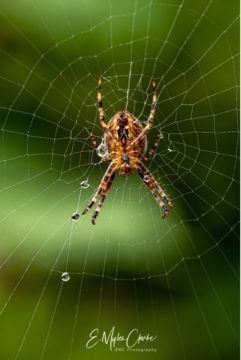
John Keats can be forgiven for overlooking the spiders in his ode “To Autumn”. Who can blame him for accentuating the positive, given the health issues that eventually overcame him, barely 25, in his rude room by the foot of the Spanish Steps?
My sometime island abode in the Salish Sea, the inland sea that touches Vancouver and Seattle and is home to the Canadian Gulf Islands and the American San Juans, is a long way from the Spanish Steps and a favorite haunt of spiders in autumn. Early on a late September morning on the cliff-edge path to Gowlland Point, dewdrops sparkle like diamonds in elaborate silken webs draped over long grasses with exquisite care. Spiders are to autumn as strawberries are to June. What’s not to like?
An older cabin in the woods is an invitation to wildlife invasion. Black-tailed deer content themselves with napping under the deck, and river otters make the quarter-mile trek from the ocean on rare occasions to investigate the crawl space as a potential den, but entering the interior of the cabin is the particular province of birds and bats (accidentally) and spiders (less so). Field mice would gladly join the parade, and have done so in the past, but for the time being are flummoxed by plugs of steel wool in every mouse-sized hole. Their tactical engineering squads are believed to be working on solutions every day. As for other invaders, live rescues are my preferred approach. Hummingbirds and wrens can be trapped in Tupperware containers, a sheet of cardboard slipped over the opening, and released outdoors. A juice glass will suffice for errant wasps and moths.
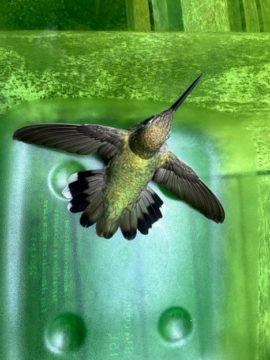
This practice has less to do with any spiritual belief I might hold than it does with the debatable proposition that a human life is worth more than any other. I confess, however, to making an exception, on occasion, for two very specific groups of animals: those with legs numbering more than six and those with legs numbering fewer than one. I blame this on a ragtag bunch of distant ancestors who lived in the forest or savannah without benefit of walls and ceilings, setting the stage for random instinctive phobias hundreds of generations later.
That said, much depends on the size and location of spiders. Those found in the sink at the break of day get the juice glass treatment, but juice glasses are less effective for arachnids scurrying into dark recesses in bedsheets or fixing a multiple-eyed gaze upon my person from the ceiling above my head. Should I argue with killer instincts handed down from Neanderthal forebears? It’s a moral dilemma infrequently addressed in a modern world where moral dilemmas seem to multiply by the month. Sometimes there’s no fighting gut reaction, especially when a Dyson stick vac lies within reach on a nearby wall.
Other spiders winter over on the wall outside the kitchen door, though not of their own free will. These are the spiders carried here by the mud dauber wasp that paralyzed them with its sting before depositing them in a tiny mud apartment, purpose-built to accommodate them together with an egg, then sealed tight against the elements. Sooner rather than later, the egg will hatch into a wasp larva with a prodigious appetite. No worries. Mom has thought of everything (Dad went through the motions of guarding the apartment under construction, then took off). There’s nothing like a paralyzed spider or two if you’re feeling a little peckish and you happen to be a wasp larva. If Mom has paralyzed several spiders for you, so much the better. You’ll stuff yourself and hang out here until spring before gnawing a hole in the mud wall and exiting to repeat the age-old cycle as a grown-up mud dauber wasp.
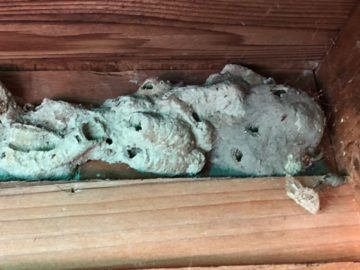
I can’t remember how many years ago I first noticed the mud dauber wasp condo under the eaves outside the kitchen door, but ever since I have watched with fascination the addition each summer of one new mud cell—just one, because mud dauber wasps are solitary creatures working only in couples. My worst fear is that a well-intentioned cabin visitor will see in the mud wasp condo nothing more than a muddy blotch in need of a broom. Fortunately it hasn’t happened yet.
The inch-long mud dauber wasp is narrow and ungainly, resembling in flight an insect version of a great blue heron, all outsized wings and long dangling legs, but a formidable hunter for all that. Evolution displays its small miracles to us every day, if we only care to look, though it rather boggles my mind how random selection came up with the notion of paralyzing spiders and building a dungeon cum nursery in which to house them. Some things are just meant to remain mysteries, without the need to consign them to the God box.
But enough about spiders, be they itsy bitsy or zilla. On to mists and mellow fruitfulness.
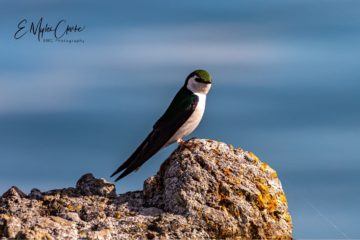
Officially, autumn begins with the autumn equinox, the moment in late September when day and night are of equal length, but nature heralds the coming of autumn long before the calendar registers its arrival. By late summer, the chocolate lilies and camas whose flowers carpeted the headland overlooking Haro Strait last spring have scattered their seeds into the long grasses, setting the stage for a new generation. Then follows the extended migration period of all manner of wildlife species with an aversion to Canadian winters, no matter how mild.
First in line are the violet-green swallows and rufous hummingbirds, which begin to lift off for Central America and points south by mid-August. Turkey vultures, by contrast, linger until late September, when they kettle (wheeling and circling as a group) to await the southbound breeze with the strength to lift them across the Strait of Juan de Fuca, the first leg of their journey to Venezuela or Ecuador. Among the last to leave the island waters are the humpback whales, though they migrate for a different purpose—to birth and raise their young in the waters off Mexico and Hawaii before returning in late spring to the Salish Sea with their offspring.
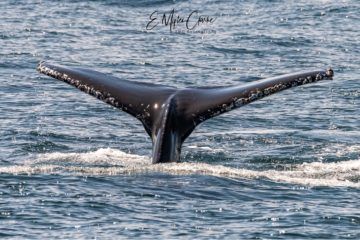
With most songbirds having left for the winter, the autumn soundscape undergoes a subtle shift. Field crickets on the grassy point record the changing season by slowing their chirps in concert with gradually declining temperatures, one chirp a second equating to 52 degrees Fahrenheit under the formula prescribed by Dolbear’s Law, generally accurate for all but the most nonconforming crickets. Less metronomic will be the distant ring of neighbors’ axes splitting a woodshed’s worth of Douglas-fir for the long winter ahead. Pileated woodpeckers continue to honor their obligation to awaken humans at the crack of dawn, drilling for grubs underneath bark with the enthusiasm and volume of jackhammers, their feeble brains cleverly cushioned by a wraparound tongue of extraordinary length (a tale for another time). Still more obnoxious in fall is the bellow of container ship foghorns, activated every two minutes in fog and required by law to be audible at least two nautical miles away. They echo hundreds of yards through the forest, accompanied in the case of larger ships fighting the tide by a deep vibration that seems to shake the very ground beneath the cabin. Fog starts appearing on the sea in late summer, so frequently in some parts of the North Pacific that mariners on Vancouver Island’s west coast have taken to referring to the month after July as Faugust.
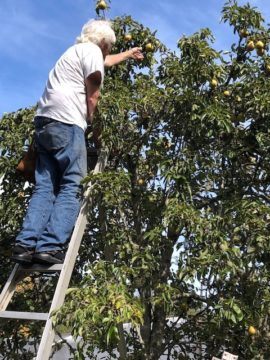
So much for mist. As the impacts of climate change pick up speed, mellow fruitfulness has become a hit-and-miss affair. For the so-called Mediterranean climate of the Salish Sea, climate change generally means hotter and drier summers and windier and wetter winters. Last year I helped my neighbor Ken pick boxload after boxload of pears from his orchard before the black-tailed deer and yellowjackets could lay waste to them. This year, a cold and sodden spring stretched on into early summer and sabotaged the production of blossoms. The result? Hardly enough pears to fill a single box. Smaller pollinator populations may have been a factor as well. Another of nature’s uncertainties, other than the certainty that human pigheadedness, as usual, remains the lead suspect, no disrespect intended towards pigs. Hence no mellow fruitfulness this year, blackberries excepted.
The Himalayan blackberry, which despite its name originated somewhere in the neighborhood of Persia, must be a contender for the most successful and aggressive invasive species ever. It claws its way through field and forest, ingeniously rooting the leading tips of its canes or relying on birds to spread its seeds farther afield, while smothering native plants in its path. It’s seductive and dangerous in equal parts. Himalayan blackberries are like the rough distant cousin of the red raspberry—a dark and brooding, prickly Heathcliff to the raspberry’s bright, well-mannered Cathy. You know you really shouldn’t associate with it, but then you think, well, blackberry pie. Your relationship might not end well, but at least you’ll have the memory. While matchmakers turned their backs on Heathcliff and Cathy, they couldn’t stay away from blackberry and raspberry. The result was offspring with names like boysenberry and loganberry and tayberry, each of them alluring in its own way and reasonably well behaved, especially with the benefit of early discipline judiciously and frequently applied.
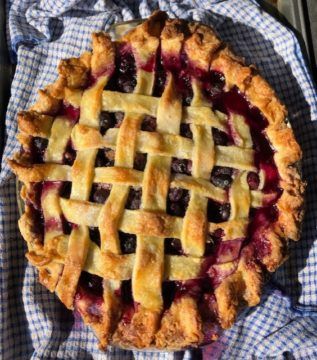
I had assumed the glade south of the cabin to be too shady for blackberry bushes to survive, but in early September this year I stumbled across a single long stem that I was about to dispatch with my secateurs until I noticed its tip was seductively heavy with fruit. For the moment I’ve left it be, though I’ve put it on notice. Blackberries may be evil, but they do have certain advantages over spiders.
But now even the late blackberries are turning to mush and bigleaf maple leaves are starting to detach and thud to the ground on the cabin driveway like large reluctant drops of rain, a precursor to the real McCoy that will soon once again refill the dug well and saturate the earth. All too soon, the season of mists and mellow fruitfulness will yield the stage to the season of rains and sodden fretfulness. Winter’s advance frosty guard won’t be far behind, probing for vulnerable pipes to freeze and unsuspecting trees to topple when the storm winds shift unexpectedly from southeast to north. That’s when the maples and firs and cedars start to shed vulnerable limbs and the power goes out, not for hours but days. Then without advance notice arrives the season of outhouses and oil lamps and crackling woodstoves and board games by candlelight. And books instead of wifi. One could wish for worse.
***
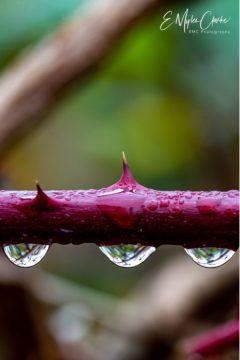
Thanks to Myles Clarke for generously contributing photos for this article (Instagram @emylesclarke) and to Paul Petrie for dropping everything for an urgent request to secure a photo of the mud dauber wasp condo on the cabin wall.
